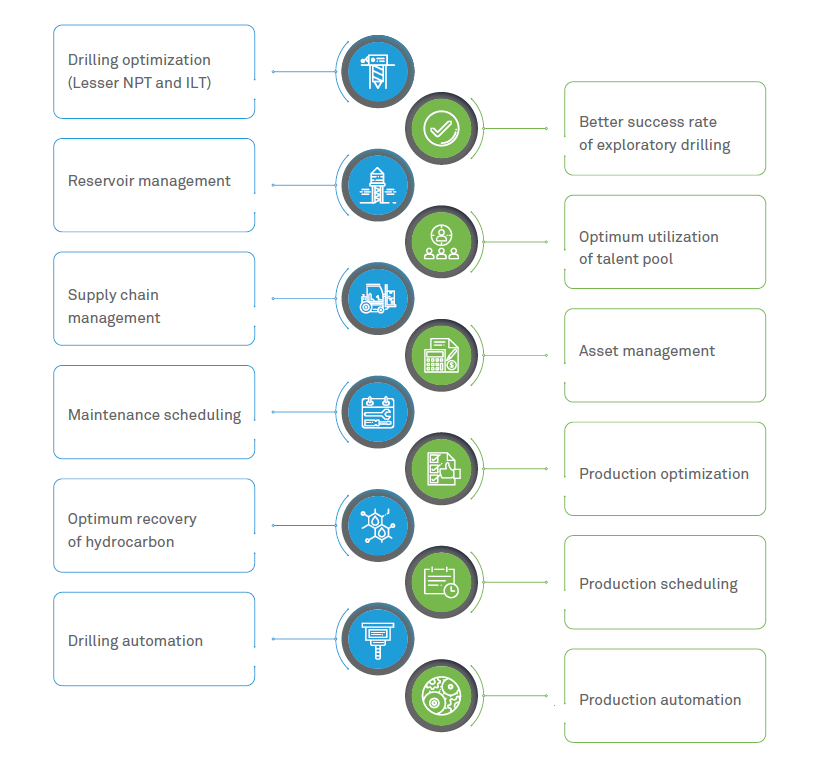Oil and gas fields are often present in deserts, dense forests, shallow and deep-water locations. Issues related to logistics and supply chain pose a great challenge in the management of operations at such locations. At offshore locations, personnel are ferried, mobilized and demobilized by helicopters. Due to capacity constraints, only necessary operation support personnel can stay on a drilling or production platform. People are mobilized on call basis and ferried back to base after work completion. Basic amenities and resources like food, water, housekeeping material, engineering equipment, chemicals and tools are provided to the offshore location from the supply base by supply vessels and boats which take several hours to reach a drilling rig or production platform. In the event of natural calamities like hurricanes and storms, evacuation of personnel and securing assets is a major challenge to oil and gas operators.
Oil and gas well engineering operations are complex and integrated, and require real time intervention by experienced personnel. Since the well is constructed in hostile subsurface pressure and temperature regimes, hazardous and catastrophic events like well control and blow out are possible, which need to be averted and mitigated. Well control and stuck pipe events need immediate intervention by experts. A blow out is a catastrophic event which can lead to loss of life, property and assets. To mitigate and overcome such crises, integrated operations are required which need active real-time involvement of drilling engineers, pore pressure experts, drilling fluid engineers, geologists, petro-physicists, measurement-while-drilling personnel, instrumentation engineers and related support staff for safe and efficient well construction activities.
Integrated operations in oil and gas industry is about implementation of new and innovative work processes, which has been facilitated by next gen information and communication technology. Integrated operations involves effective communication and collaboration between experts and field crew with an intent to support a common cause of safe and efficient well construction and production which ultimately leads to discovery and production of oil and gas in commercially viable proportions.
Oil and Gas operators have their expert pool spread across different geographies. Making them available for critical and emergency operation support in real time can be enabled by integrated operations technology. A pore pressure engineer located in Houston can drive a critical well control emergency in Indian offshore locations by a digital collaboration environment.
Since large volumes of drilling and production data are generated in well construction and production operations, one of the objectives of integrated operations is to optimize the utilization of this data to provide real time decision support and create and share meaningful insights which can help reduce non-productive time and invisible lost time.
Technologies like big data and analytics, data science, machine learning, and artificial intelligence, are enablers of integrated operations. Real time streaming of large data volumes from multiple rig sites located in an oil field to an Integrated Operation centre can enable simultaneous ingestion and integration of this data into a big data platform. Insight engines and real-time analytics engines can generate meaningful insights which can be shared in real time to all rig sites. This sharing of insights in real time can help individual rig crews attain more efficiency and safety.
3D visualization of operations in RTOC and RTO can provide a better look and feel of operations compared to 2-D visualization of logs and plots. Animations can provide a look and feel of subsurface activities and operations. Professional animation companies are now creating designs for operation visualization in Integrated Operation centers. Streaming of large data volumes has also enabled video analytics which helps real time views of a well site at integrated operation centers. Video analytics is a very powerful tool for HSE management at well sites. Facility engineers and Offshore installation managers can use video footage for surveillance purposes. Offshore surveillance can be done from integrated operation centers.
In coming years, more technology levers will enable remote control of operations from Integrated Operation centers. Well site activities and operations will be controlled and managed from RTOC and RTO. Technology will play a big role in E & P operation automation. In coming years, digital technologies will transform oil and gas business processes. Tangible benefits of the same to the oil and gas industry will be obtained. Some of the tangible benefits and potential areas of implementation are mentioned below.

Dr. Sunil Khare - Managing Consultant (Upstream Oil & Gas), Wipro Ltd
Dr Sunil is managing consultant in Upstream Oil and Gas Practice of Wipro and leads a team of domain and techno-domain professionals working in Upstream projects. Over a period of 20 years, Dr Sunil has had extensive experience in oilfield services as field engineer and in IT industry as business analyst, product manager and business consultant. He has led drilling and completion, real time services and WITSML application support and product development projects of Wipro’s global oil and gas clients.
In his role as a consultant Dr Sunil has successfully led and mentored multiple domain-centric projects in India and abroad, which has improved drilling operation efficiency and brought down non-productive time of clients. He is driving activities around domain-centric digital and automation projects in upstream.
His interest and expertise areas include 3-D visualization, animation, drilling analytics and application of AI, machine learning and cloud in digital transformation of upstream business processes.